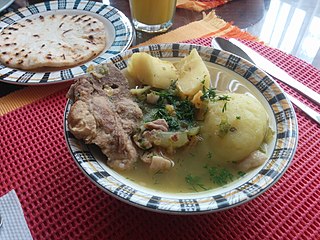
Ceviche, cebiche, sebiche, or seviche is a dish consisting of fish or shellfish marinated in citrus and seasonings, recognized by UNESCO as an expression of Peruvian traditional cuisine and Intangible Cultural Heritage of Humanity, although different versions of ceviche are part of the culinary culture of various Spanish-American countries along the Pacific Ocean where each one is native: Chile, Colombia, Costa Rica, Ecuador, El Salvador, Guatemala, Honduras, Mexico, Nicaragua, Panama and Peru. In Peru it is also considered a flagship dish and cultural heritage.

Tripe is a type of edible lining from the stomachs of various farm animals. Most tripe is from cattle, pigs, and sheep.

Malaysian cuisine consists of cooking traditions and practices found in Malaysia, and reflects the multi-ethnic makeup of its population. The vast majority of Malaysia's population can roughly be divided among three major ethnic groups: Malays, Chinese and Indians. The remainder consists of the indigenous peoples of Sabah and Sarawak in East Malaysia, the Orang Asli of Peninsular Malaysia, the Peranakan and Eurasian creole communities, as well as a significant number of foreign workers and expatriates.

Malay cuisine is the traditional food of the ethnic Malays of Southeast Asia, residing in modern-day Malaysia, Indonesia, Singapore, Brunei, Southern Thailand and the Philippines as well as Cocos Islands, Christmas Island, Sri Lanka and South Africa.

Latin American cuisine is the typical foods, beverages, and cooking styles common to many of the countries and cultures in Latin America. Latin America is a highly racially, ethnically, and geographically diverse with varying cuisines. Some items typical of Latin American cuisine include maize-based dishes arepas, empanadas, pupusas, tacos, tamales, tortillas and various salsas and other condiments. Sofrito, a culinary term that originally referred to a specific combination of sautéed or braised aromatics, exists in Latin American cuisine. It refers to a sauce of tomatoes, roasted bell peppers, garlic, onions and herbs. Rice, corn, pasta, bread, plantain, potato, yucca, and beans are also staples in Latin American cuisine.

Locro is a hearty thick squash stew, associated with Native Andean civilizations, and popular along the Andes mountain range. It is one of the national dishes of Peru, Bolivia, Ecuador, Chile, Paraguay, Northwest Argentina and Southwestern Colombia.

Chili powder is the dried, pulverized fruit of one or more varieties of chili pepper, sometimes with the addition of other spices. It is used as a spice to add pungency (piquancy) and flavor to culinary dishes. In American English, the spelling is usually "chili"; in British English, "chilli" is used consistently.
Peruvian cuisine reflects local practices and ingredients including influences mainly from the indigenous population, including the Inca, and cuisines brought by immigrants from Europe, Asia, and Africa. Without the familiar ingredients from their home countries, immigrants modified their traditional cuisines by using ingredients available in Peru.

Sancocho is a traditional stew in Canarian cuisine and several Latin American cuisines. Latin variations represent popular national dishes in Dominican Republic, Colombia, Cuba, Honduras, Mexico, Ecuador, Panama, Puerto Rico, Trinidad and Tobago, and Venezuela. It usually consists of large pieces of meat, tubers and vegetables served in a broth.

Ají is a spicy sauce that contains ají peppers, oil, tomatoes, cilantro (coriander), garlic, onions, and water. It is served as a condiment to complement main dishes, most oftentimes in Latin American cuisines, and prepared by blending its ingredients using a food processor or blender. Although ají sauce recipes can vary from person to person, there are generally country-specific and region-specific varieties.

Chili sauce and chili paste are condiments prepared with chili peppers.

Nigerian cuisine consists of dishes or food items from the hundreds of Native African ethnic groups that comprise Nigeria. Like other West African cuisines, it uses spices and herbs with palm or groundnut oil to create deeply flavored sauces and soups.
The seco is a stew typical of Ecuadorian Cuisine. It can be made with any type of meat. According to an Ecuadorian popular etymology, the name of seco comes from the Península de Santa Elena in Ecuador, where at the beginning of the 20th century a camp English did oil work in Ancón, when referring to the second course of food, in English "second", the Ecuadorians repeated deforming the word until they reached the current "seco", which has been widely disseminated, despite being a myth, since records of this dish have been found since 1820, almost a century before the English presence in the Santa Elena Peninsula. At that time, deer and Creole goats abounded. According to the Dictionary of Peruvianisms of the Peruvian Wings University, seco is a «stew of beef, kid or another animal, macerated in vinegar, which is served accompanied by rice and a sauce of ají, huacatay and cilantro”. Thus, its main characteristic is to marinate and cook the chosen meat with some type of sauce acid, such as chicha, beer, naranjilla or vinegar.

Gastronomic Fair of Trujillo called Sabe a Peru is a gastronomy festival held in the Peruvian city of Trujillo. This festival has been held on 17 and 18 November 2012. It took place in Mall Aventura Plaza Trujillo. In 2012 the festival paid tribute to the "mochero chili" for being an indigenous product, Moche culture legacy. Its historical roots are attractive to encourage experiential tourism in ancestral plots of Trujillo.












